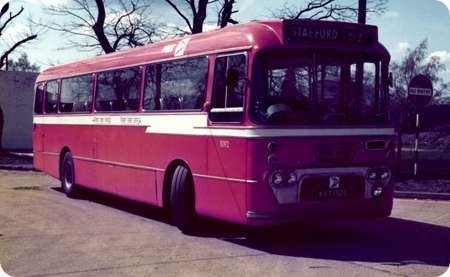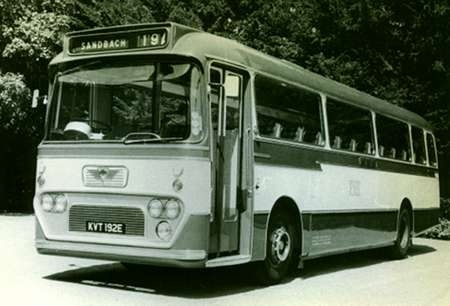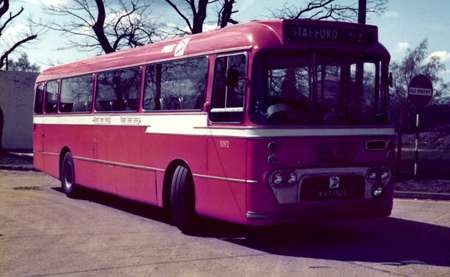
Potteries Motor Traction
1967
AEC Reliance 8U2R
Alexander C49F
A firm favourite of mine was the A.E.C. Alexander Y type, what a difference these buses made to our Excursion and Express allocation. I worked at this time on the P.M.T. based at Newcastle Under Lyme depot none of these vehicles were based there at this time they were mostly at Hanley depot (Clough Street) there was a total of about 24 delivered between 1967/1971 the 1967 ones had low back seats and the later ones had high back seats though the low back seats were very comfortable. They were all good for 70MPH and were very comfortable to drive with a five speed semi auto box, some drivers complained about the bouncy ride (coil springs) but in my book they were superb. As far as I can recall they were fitted with the 691 Engine and the company prefix was S.L (semi luxury) as they got older they were dispersed among all the depots and we at Newcastle acquired 103/1092. Happy days.
Photograph and Copy contributed by Michael Crofts
28/05/13 – 17:12
Never knew these 8U2Rs (coil sprung 6U2Rs) despite living on the Peak District/Sheffield border. I preferred the ZF version proliferating at SUT, but it would have been a (good) experience to sample one of these. [They would have been AH691s between 1968 and 1971, they might possibly have still been AH590s in 1967.]
David Oldfield
29/05/13 – 07:04
Yes David they were a mixture, the early ones had the 590 engine and the later ones had 691 engine. When you revved the coil spring buses stationary you could get them to rock, good engine torque. The later deliveries had leaf springs.
Michael Crofts
31/05/13 – 06:27
This has produced a mental block in the little grey cells! In 1967 my job took me from my home town of Sheffield to work in Newcastle-under-Lyme. I didn’t have a car then and used to make visits home, as I recall, on PMT from N-u-L to Buxton where I would change to a Sheffield JOC service 84 which would usually be either a Fanfare, Burlingham or ECW Leopard. My mental block is around the PMT vehicles completing this scenic marathon. I think it was sometimes an Alexander Y type but think that there was sometimes a Daimler. Perhaps a Potteries watcher can remember more?
Les Dickinson
04/06/13 – 06:52
All the PMT AEC /Alexander Y types had AH691 engines. The first two batches (1092-1096 and 1103-1109) were on 8U2R coil spring chassis. Of the final batch of 12, (161-173), the first three were 8U2R whilst the balance from 164 upwards were on conventional 6U2R leaf spring chassis. I am not aware whether any other Companies bought 8U2R, would seem a major design change for small orders from PMT. Maybe AEC had hopes of bigger sales? Maybe by 1971 they had deleted the 8U2R model from their lists? However by 1971, experience with the earlier 8U2Rs suggested that the savings in replacing leaf springs was more than outweighed by problems with panhard rod mountings (not dissimilar in this respect to the problems experienced with the Metalastik rubber sprung Roadliners.) PMT also had two small batches of AEC 8U2R/Duple Commander 1V coaches, 11-13 and 14/15. In response to Les, in 1967 the 49 Hanley to Buxton service would probably be operated then with almost new Daimler Roadliners.
Ian Wild
As a ps, what a dismal colour scheme that 1092 is in the photo. These looked so smart as delivered in the PMT dual purpose livery. Brings back memories of the dire days of NBC (and for that matter PTEs).
09/06/13 – 06:26
In answer to my own question, looking through Bus Lists on the Web, only 30 Reliance chassis are shown as 8Uxx (should actually be 33 as they list PMT 161-163 as 6U2R models which they certainly were not). PMT had 19, Barton are shown with 10 whilst South Wales Transport had two batches of 2 each. So, the coil sprung version accounted for only a tiny minority of the large number of Reliance chassis built.
Ian Wild
18/06/13 – 09:08

Here is a picture of AEC Alexander Y Type KVT 192E when brand new showing it in its original livery. It would be good to see both pictures together.
Michael Crofts
19/06/13 – 07:45
That’s much better and how I remember them. Fortunately I had moved on from PMT before the dreadful NBC Corporate livery was imposed. The last vehicles delivered in my time in the ‘real’ PMT livery were the three Bristol RE DPs 210-212. Do you have a photo of them? I never took one but I remember them being elegant looking buses.
Ian Wild
20/06/13 – 13:35
Sheffield had some of these. I think they were Alexander bodies. They had coach seats with large windows, & bus seats with more, smaller windows. Living on Scott Road, (De La Sall stories lads?) but working from Broomhill, I used to catch the 7.25 from Burngreave Cemetry to work, 1967 or later on the 8 & 9 Inner Circler route. Going up the steep hill of Crookesmoor Road (another) was the most remarkable sound. How it did not break windows I do not know (or probably it did). I think they had gear sticks similar to the Atlanteans (semi automatic)? They took over from the AEC Regent III Roes, & tinfront Roes. These took over from the Crossley (double deckers) which has just been posted on the home page. After that were the AEC Marshalls H reg 1970. I am sure these were still running into the early 80s when I lost touch with the area.
Andy Fisher
20/06/13 – 16:47
The Sheffield coaches were 1968 Leyland Leopard PSU3A/4R (not AEC) 3001 – 3004 (WWB101-104G) and followed by similar (1970) 55 – 60 (FWJ355-369J). The 1970 AECs were Swift 5P2R 50 -54 (DWB50-54H) with Park Royal bodies – which followed on from similar 1968 vehicles. The 1970 Swifts had rear axles and 5 speed gearboxes for interurban and rural working, the 1968 deliveries were 2P2R (4 speeders) split between single and dual door types. The former were 1019 – 1029 (TWE119-129F), the latter were 15 – 36 (TWE15-36F).
David Oldfield
 Vehicle reminder shot for this posting
Vehicle reminder shot for this posting
10/07/19 – 07:09
With regards to the RE DPs 210 to 212 I recall that at least one arrived at Stoke in the service bus livery- red with a cream band and window surrounds. It was hurriedly placed in the paint shop where the middle panels were painted cream.
Leekensian
Leave a Reply